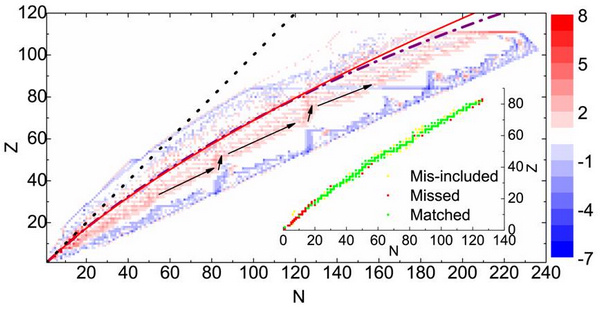






Recently, with a distinctive view revealed by improved methods of multilayer networks in studying nuclear reaction system, researchers from Shanghai Institute of Applied Physics (SINAP), Chinese Academy of Sciences, cooperating with East China Normal University (ECNU) and Shanghai Key Laboratory of Multidimensional Information Processing (SKLMIP), explored the relationship between physical characteristics of nuclides and their corresponding nodes’ network structure, which provides new perspective for nuclear data prediction. The article is published online in Scientific Reports (Scientific Reports 6:31882 (2016)) under the Nature Publishing Group on Aug. 25, 2016.
Nuclear astrophysics pays close attention to some of the most challenging questions in nature: How did the elements originate and generate life on earth? How did the universe come into being and evolve? Will they collapse eventually or expand forever? Various nuclear or astrophysical models and massive data are required to carry out the studies. However, due to the limits of technology, in the laboratory environment it is difficult to meet the hash criteria like high temperature and density for measurements. Hence, a large portion of data like cross section, mass and nuclear structure depend on simulation. The method of nuclear reaction network often seen in the calculation of nuclear astrophysics is reductionism-oriented, which acquires exact nuclide abundance by solving sets of time-dependent differential reaction equations. Meanwhile, complex network theory in statistical physics has found its application in many areas and shown advantages as a method under holism category. It fills the gap to analyze the nuclear reaction system statistically as a complex network to explore its large-scale structure characteristics, and can benefit the research in the area of nuclear astrophysics.
The researchers mapped over 80,000 thermonuclear reactions in REACLIB database collected by JINA (Joint Institute for Nuclear Astrophysics) into a directed weighted network with 4 layers. More than 8,000 nuclides are treated as nodes, the reaction relationship as edges, connecting from reactants to products. Edges are labeled with particles consumed in the reactions into 4 kinds: neutron (n), proton (p), 4He (h) and the remainder (r). Reaction rates are considered as node strength, which is a function of temperature. It is shown that the network structure of nuclear reaction system is quite different from previously studied ones. Three layers of the 4-layered network are quite regular: n, p, h, while r-layer possesses more complexity. There is high correlation between nuclide half-life and structure metrics of r-layer, such as degree difference, node overlap coefficient and strength. The temperature-dependent strength may take the credit for the complexity of the whole system. The results would push forward the understanding of questions like the boundary of the nuclide chart, the limits of nuclear binding and the island of stability.
This research is directed by Prof. Ma Yu-Gang and carried out by one of his PhD students Zhu Liang. The staff of ECNU and SKLMIP also participated in the result analysis. The research is supported in part by the National Science Foundation of China for Innovative Research Groups and the National Basic Research Program of China (973 Program).

Figure 1. The topology and multilayer network structure of nuclear reaction system on a Z-N plane (left panel). The topology plotted using special layout algorithm (right panel)

Figure 2. The structure characteristics of network fit beta-stability line well